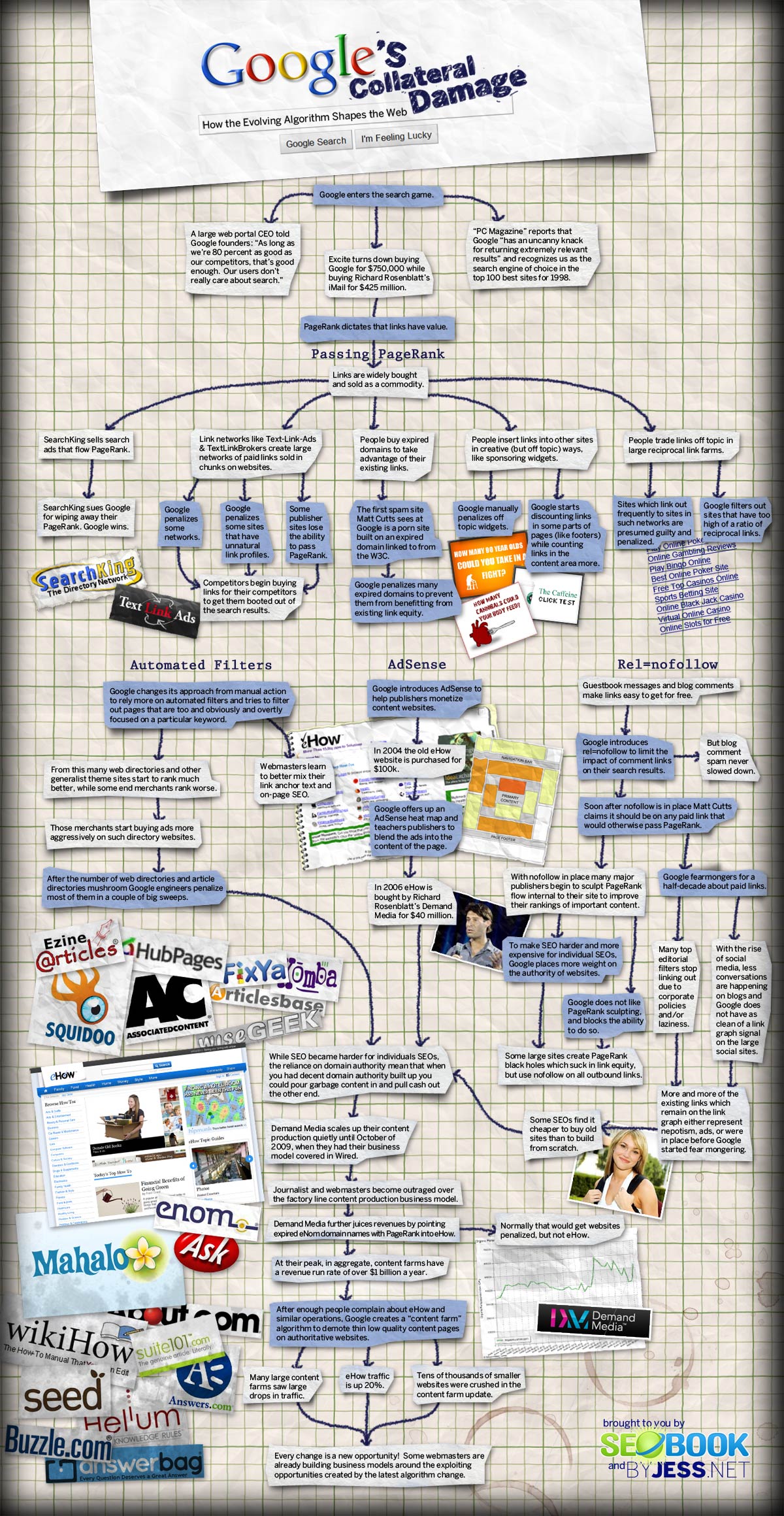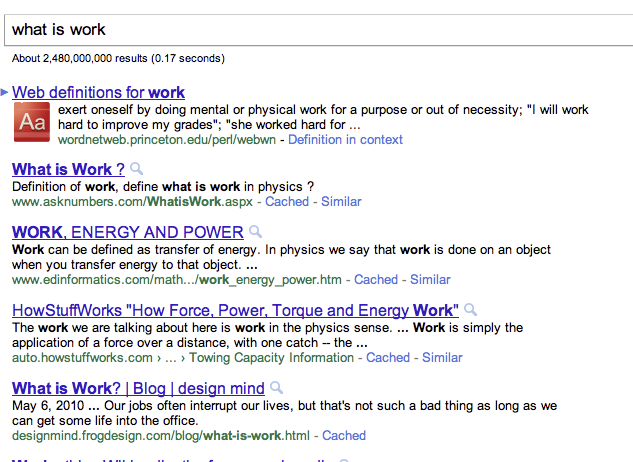I just received a form letter response for a reconsideration request. A generic response to a letter submitted after hundreds of hours of effort certainly doesn’t come as news to anyone who has been or works with clients penalized by Google, but if I may mix a few metaphors, this is rubbing salt in an open wound poured by a vengeful and arbitrary god.
I should start with a little background. In April of this year I was engaged by LogoGarden.com to determine why their Google traffic had suddenly fallen. Within a few seconds it was obvious that the site had been penalized and before I accepted the project I asked the client about their link building history. I was assured that while they had engaged two highly respected SEO firms to build links to their site, they had been assured that no links would be purchased on their behalf and that only “white hat techniques” would be employed to garner high quality links from relevant sites. Here is John Williams’ summary of their link building:
In 2010 we had a link building campaign for logogarden.com conducted by Stone Temple Consulting which is owned by Eric Enge. He assured me at the time that they would not buy any links. The other link building activity for LogoGarden was conducted by SlingShot SEO from November 2011 to February 2012. They were recommended to us by Jillian Muessig of SEOMoz as a “white hat link builder”. Again, they were only asked to build links to LogoGarden.com and they specifically were instructed not to buy links.
After an aggressive round of onsite de-optimization failed to product any results, I turned to analyze their back link. It should come as no surprise by this point in the narrative to hear that was I found was not pretty. Over 20,000 links from about 1,000 linking domain. Most of the links were from sites that were obviously spam and about half used the exact match phrase “logo design”. In short, just what you would expect to see if you hired a bunch of crappy links from Fiver.com or engaged an off shore link developer in response to an email — and exactly what the client swore he never did.
Digging further, a couple of patterns became obvious.
- The vast majority of these links were added from October 2011 to January 2012.
- Links were pointed at both LogoGarden.com and LogoGarden.co.uk
The importance of these facts is quite simple; LogoGarden did not have ANY link builders engaged during October and most of November AND neither of the link building engagements were asked to target the UK site, making it extremely unlikely that the damage was done by their SEO firms. In addition, the start of this link surge corresponds with a copy write dispute that LogoGarden had with a couple of prominent designs.
Analyzing the facts, I became convinced that LogoGarden.com is the victim of a prolonged and effective Negative SEO attack. Knowing you are a negative SEO victim and proving it are two different things.
No link profile is pristine. Even a site that has never engaged in any link building has been scraped, spun, rehashed and mashed up in enough places that some bad links will exist. That is one of the challenges faced by search engines and in the era of Penguin and other link penalties it makes it especially hard for a site owner or SEO consultant to know what is going on. It is undisputable that a couple of spammy, pay per post type links to LogoGarden.co.uk dated all the way back to 2010. For a skeptic (or a search engineer), these posts provide evidence of original sin and can be used to discredit the claim that someone else is responsible.
The only recommendation I could make was for the client to embark on a link cleanup campaign precisely as if they were responsible for the links in the first place. We pulled the historical data our of MajesticSEO.com and combined it with the reports from Ahref.com and OpenSiteExplorer.org. We then processed the links into the following categories and attempted to contact every webmaster we could from the spam category.
- Spam – spam sites
- Offline – site not live
- Offline – domain expired
- Guest post submitted by John Williams
- Blog/articles about LG symbols – these are comments and/or articles about the copyright issues with some of our symbols.
- Not a junk link- industry site – these are sites that contain our link but look like legitimate industry websites that are discussing graphic design, web design, etc.
- No link- could not find LG link on the site
I am writing to request reconsideration and redress to lift the algorithmic and manual actions taken again LogoGarden.com. It it our strong belief that LogoGarden.com and LogoGarden.co.uk are the victims of a Negative SEO attack resulting in a ranking penalty.
We clearly see hundreds of links from spammy networks that are aimed at both the UK and US (.com) domains. A large volume of low quality links on expired/repurposed domains began to appear in October of 2011, aimed at both the US and the UK site; during a time period when we had no active SEO engagements. This time period also corresponds with a copyright issue we had with with a handful of graphic designers in the US. When LogoGarden was made aware of the issue, we quickly rectified the issue. While we have no evidence of who is behind the negative SEO campaign, the timing is suspicious.
We may have created some of the issue ourselves with the work done by one of our previous SEO Consultants. In 2010 we had a link building campaign for logogarden.com conducted by Stone Temple Consulting which is owned by Eric Enge. Eric’s reputation is excellent and he is outspoken against paid links. He assured me at the time that they would not buy any links and he has subsequently confirmed this with Jonah Stein, who is currently advising us on this matter. We do see a few links built in 2010 that aim at LogoGarden.co.uk are on splog sites with targeted anchor text. All evidence would suggest these are paid links but we explicitly NEVER contracted anyone to build links to the UK site. The other link building activity for LogoGarden was conducted by SlingShot SEO from November 2011 to February 2012. They were recommended to us by Jillian Muessig of SEOMoz as a “white hat link builder”. Again, they were only asked to build links to LogoGarden.com and they specifically were instructed not to buy links.
Their subsequent refusal to provide a list of links they built resulted in their termination but they still insist that they did not buy any links on these networks. Our research indicates that they mostly created forum links. They have refused to take down these links or participate in our reconsideration request.
I understand that it is difficult to prove a third party’s actions are responsible for these link as opposed to our own actions, but here are the steps we have taken to address the issue:
1. We have attempted to contact the owner of every blog site/network that is linking to LogoGarden.co.uk with targeted anchor text to ask them to remove links. Details, on a site by site basis, are included here: https://docs.google.com/spreadsheet/pub?key=0An8EJTH0YMtkdHFNeGVtWncza2tKZU1fUHdWOXVEYmc&output=html
2. We have attempted to contact the owner of every blog site/network that is linking to LogoGarden.com with targeted anchor text to ask them to remove links. Details, on a site by site basis, are included here: 3. We have offered a $10,000 reward for proof of who is paying for them to be built in the first place and have been actively promoting this reward to every site we contact to request a link removal. Here is a link to the article: http://www.logogarden.com/blog/branding/negative-seo-victim-strikes-back/
Here is the actual letter we have either sent to or entered in the contact form of hundreds of sites. $10,000 reward:
My company, LogoGarden.com has been scammed by malicious SEO behavior. I’m offering USD $10,000.00 for information leading to the identification of the individual(s) targeting LogoGarden.com with junk backlinks. Someone has paid blogs, like yours to post links to LogoGarden.com. Just to be clear, your business practices are not in question. You offer a service (backlinks) and it is up to companies if they choose to use your blog not.
In Feburary, 2012, LogoGarden had page one organic search for “Logo Design”. Overnight, LogoGarden’s top term “Logo Design” vanished from Google. After intense analysis, our SEO firm ruled out all possibilities but one: SEO sabotage. Someone is paying blogs with the intent of costing LogoGarden market share. Also, PLEASE REMOVE ANY OF YOUR BLOG LINKS THAT LINK TO LOGOGARDEN.COM
Please contact me atJohn@LogoGarden.com
It is not clear what else LogoGarden could have done. What is clear is that even an enormous effort to contact webmasters cannot begin to undo the damage that can be inflicted by a Negative SEO attack. A majority of these sites have no contact information and it is doubtful that most of the rest actually go to a human being who can be convinced to take action. In fact, one of the biggest thing spam sites have in common is that ownership is deliberately obfuscated and contacting the owner is virtually impossible.

